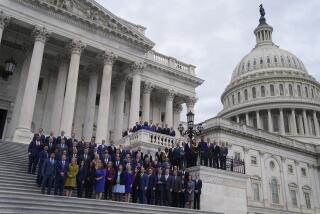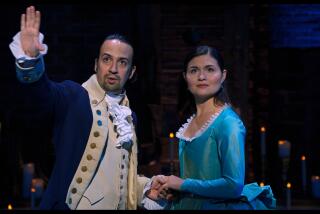A visit to our nation’s capital--and it works, if its taxicabs are any leading indicator
My wife and I have been to Washington D.C.
She had never seen the nation’s capital, the seat of our political freedom, and I thought it was time.
I called American Airlines and made reservations on a 747; I made reservations for a week at the Jefferson Hotel in Washington; we packed, and we went.
The flight was dull. The in-flight movie was one in which Rodney Dangerfield goes to college. We didn’t even rent earphones. Judging by the video, I don’t see how it could have been improved by dialogue.
We landed at Dulles International at about 4 p.m., got our luggage and stood in line for a cab. We were No. 18.
The fare to our hotel was $31, and worth it. We raced over the George Washington Memorial Parkway through groves of trees that were turning red and amber. Finally the Pentagon spun by on our right, and, going around a curve, we suddenly saw the Washington Monument, and beyond it, at the far end of the mall, the Capitol dome.
To any American, young or old, it must be a thrilling sight. We were silent as we viewed these two symbols of all that America has meant, and means, to natives and immigrants alike. It is a sight that ennobles and unifies us.
Our hotel was old and elegant and only four blocks from the White House. We were neighbors of Ron and Nancy. The furniture appeared to be of the Federal period. He couldn’t have, of course, but one could imagine Jefferson himself striding across the Oriental rugs. From our room we looked out across the National Geographic Society headquarters to see the Washington Monument, shining like a sword in the afternoon sun.
We changed for dinner. We were tourists; we wanted to do everything tourists do in Washington; but we didn’t want to look like tourists. I wore my maroon Ultrasuede jacket, navy blue slacks, white shirt and maroon and blue necktie. I’m afraid I looked a little like Rodney Dangerfield at college.
We caught a cab in front of the hotel. The doorman simply put up a finger and whistled and a cab pulled into the driveway. It was a technique I soon learned. Every sixth car in Washington is a cab. We never waited more than a minute or two. And Washington cabs must be one of the best urban bargains in America. Within the North West zone, which contains most of the city’s great public monuments, the fare is fixed, by law, at $3.35. The only time we paid more than $3.35 was in the “rush hour,” when it went up to $4.35, and when we went to the suburb of Georgetown, which was also $4.35.
Not only was the fare cheap, but the cab drivers were amiable and entertaining. They sounded Middle Eastern or Caribbean. They were also informative, being full of local history and myth--especially myth.
They were amazingly accommodating. Once we passed a small fruit stand--merely a small table on the sidewalk--and the cabbie backed up to the curb and waited while my wife bought a banana for my breakfast. (I need the potassium.)
That evening I told our driver we were going to the John F. Kennedy Center for the Performing Arts to have dinner. “They do have a restaurant, don’t they?” I asked.
He didn’t know. But when we pulled up in front of the center he told us to wait and he’d find out. He walked into the center and about half way down one of the great halls until he saw the restaurant sign. Then he came back and told us, yes, there was a restaurant, at the end of that hall and upstairs. The fare was still $3.35.
We used the subway only once: to go to the Pentagon.
From the outside the Kennedy Center is uninspiring. It is merely a massive oblong that might be another bureaucratic headquarters. It lacks the classic grace of our Music Center. Inside, it is enormous, breathtaking, luxurious and awesome. We walked down one golden-carpeted corridor hung with the flags of the nations and turned into another that led to the orchestra hall and two large theaters. It was hung with nine-tiered crystal chandeliers. I noticed that the chandeliers in front of the center theater were dimmed.
The intermission was just ending at the theater beyond it. A bartender at a movable bar was cleaning up after the intermission rush. I asked him about the dim lights.
“Oh, that theater’s dark tonight,” he said. “Whenever a theater’s dark they turn out the lights in front of it. To save power. It’s dumb, if you ask me.”
I thought of our own Water and Power Department, which turns on and lights the fountains across from our Music Center only for an hour or so on performance nights, before curtain time. (It was hard enough to get them to do that.)
It’s dumb, if you ask me.
That night, after dinner, we went into the Jefferson Hotel bar for a nightcap. It is a small, elegant, four-stool bar in a cluster of intimate dining alcoves. We fell into conversation with a young man who was sitting there alone.
He might have been a prop. He was a lobbyist of some sort. Intelligent, knowledgeable, articulate, persuasive, passionate and cynical. He was an expert on Central America. He said our policy was disastrous.
Listening to him, we somehow knew we were in the capital of the freest great power in the world.
More to Read
Sign up for The Wild
We’ll help you find the best places to hike, bike and run, as well as the perfect silent spots for meditation and yoga.
You may occasionally receive promotional content from the Los Angeles Times.






